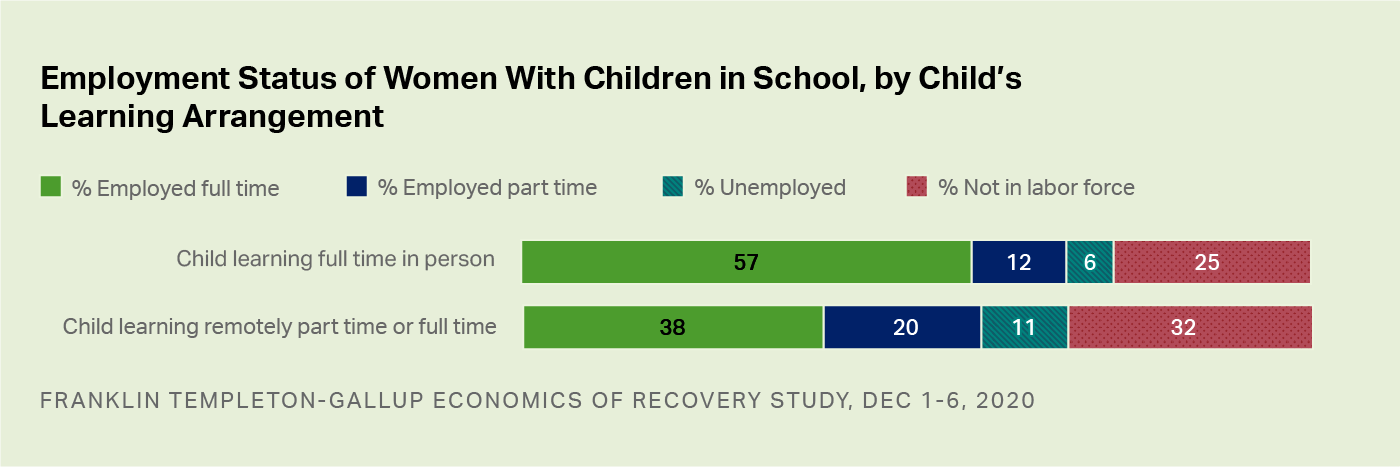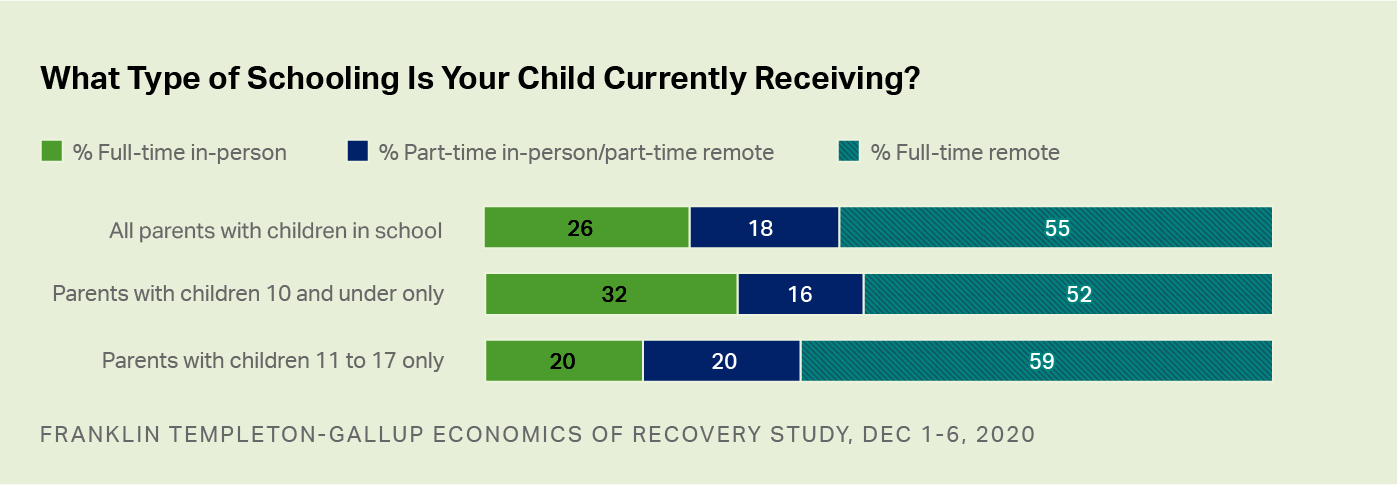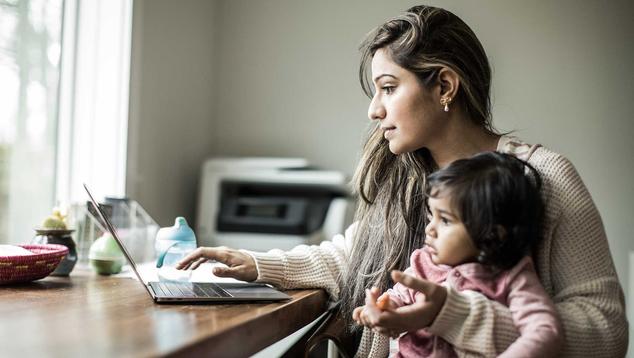Story Highlights
- 47% of parents with kids learning remotely work full time, 71% of others
- One-third of mothers with remote learners not in the labor force
- 73% of parents say their child is learning at home full time or part time
WASHINGTON, D.C. -- Among many ways in which the COVID-19 pandemic has impacted American workers is the need to look after children who are learning remotely from home. New results from the Franklin Templeton-Gallup Economics of Recovery Study indicate parents with children in remote-only or hybrid learning situations are much less likely to be employed full time than those whose children are learning entirely at school -- 47% vs. 71%, respectively.
Parents whose children are engaged in distance learning are significantly more likely than those whose kids are at school full time to be out of the labor force altogether -- 24% vs. 15%. They are also about twice as likely to be working part time (18% vs. 9%) or unemployed (11% vs. 5%).

Stacked bar graph. The employment status of Americans with children in school, by their child's learning arrangement. 71% of Americans who are employed full time have children in full-time, in person learning arrangements, compared with 9% of those employed part time.
These results are based on interviews with 1,374 parents of school-aged children, a subset of 5,009 web-based surveys with U.S. adults completed December 1-6. This study is conducted via an opt-in web panel. The sample has been adjusted statistically to ensure it represents key subgroups of the U.S. adult population in their proper proportions.
Among Americans overall, women are less likely than men to work full time, and the same is true of parents -- 41% of women with school-age children currently report working full-time vs. 69% of men. However, there are substantial differences by children's learning arrangements among both mothers and fathers. Among women with children learning full time at school, a clear majority -- 57% - say they are working full time, but this drops to 38% of those whose children are learning remotely all or part of the time. The flip side of this is that the proportion of mothers who are out of the labor force rises from one-fourth (25%) among those with children full-time in school to one-third (32%) among those with children learning remotely.

Stacked bar graph. The employment status of American women with children in school, by their child's learning arrangement. 57% of American women who are employed full time have children in full time, in person learning arrangements, compared with 12% of those employed part time
Among fathers, those with children learning remotely are also considerably less likely than those with children learning exclusively in-person to be working full time - 61% vs. 87%, respectively. Men with distance-learning kids are more likely than those with children in school full time to be working part time (14% vs. 6%), to be unemployed (12% vs. 3%) or to be out of the labor force (12% vs. 3%).

Stacked bar graph. The employment status of American men with children in school, by their child's learning arrangement. 87% of American men who are employed full time have children in full time, in person learning arrangements, compared with 6% of those employed part time.
73% of Parents Say Their Child Is Learning Remotely Full or Part Time
These differences suggest that parents may have had to adapt their work situations in order to be home with their school-aged children during the pandemic. The survey did not ask about employment prior to the pandemic, so it is not possible to know if those in the various work statuses now have changed their work status from before the pandemic. However, remote learning has become prevalent in much of the country, particularly in December and January, as COVID-19 cases have reached record levels.
The current survey finds that 26% of parents with children in school say their child is learning in-person full time, while 55% say their child is learning remotely full time, and 20% say their child is in a hybrid part-time in-person/part-time remote arrangement. Parents with older children (20%) are less likely than those with children 10 and under (32%) to say their child is learning in-person full time. This may partly reflect higher coronavirus transmission rates among older children, compelling school districts to keep more of those students remote.

Stacked bar graph. The types of education arrangements of Americans' children, by child's age. 26% of all parents have children attending full-time, in person school, compared with 32% of those with children 10 and under and 20% of those with children 11 to 17.
Implications
The need to be home, and in some cases to provide educational support, when children are learning remotely is likely to disproportionately affect certain groups of workers, such as single parents and low-income, service-sector employees, who may already face economic challenges. A recent Brookings article summarizing the Franklin Templeton-Gallup Economics of Recovery Study equates school closures with many other pandemic-related factors that have hurt U.S. workers, often exacerbating existing economic and social disparities. The American Academy of Pediatrics has consistently recommended opening schools, noting that research shows that "opening schools does not significantly increase community transmission of the virus."
President Joe Biden has made restoring in-person education a top priority for his administration, announcing a plan to reopen most kindergarten-to-eighth-grade schools within his first 100 days. Though policy-makers commonly cite the need to address students' learning loss as a primary reason to reopen schools, the current findings give an indication of the boon this accomplishment would provide for working parents as well.
To receive ongoing updates about findings from the Franklin Templeton-Gallup Economics of Recovery Study, please sign up here. To learn more about the study, please visit this page.



